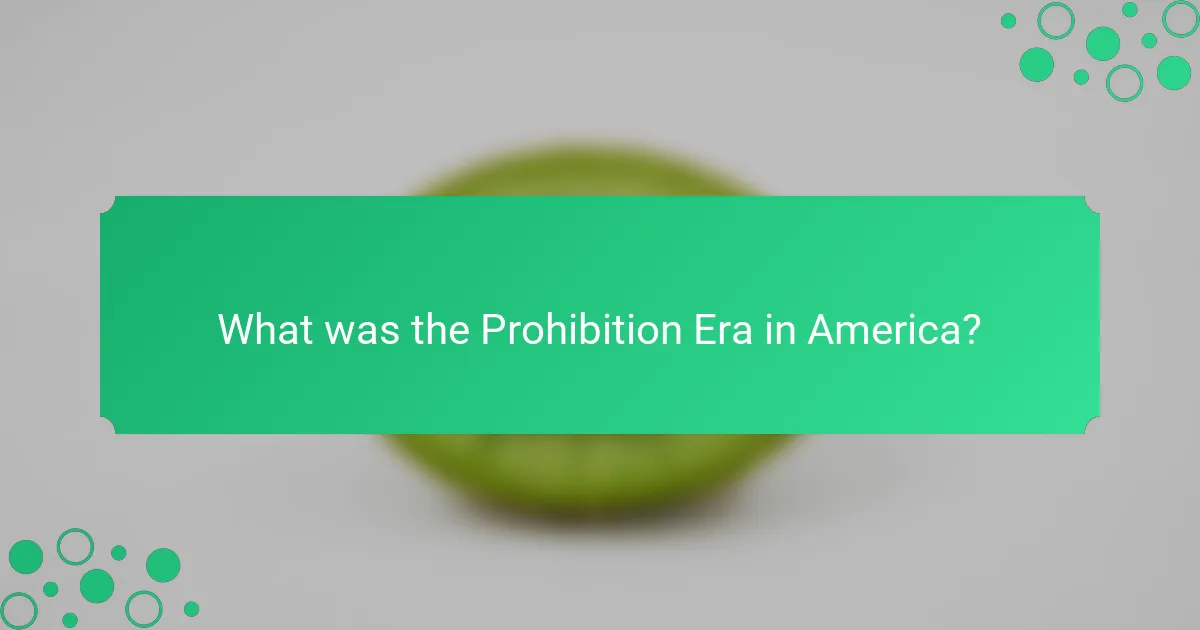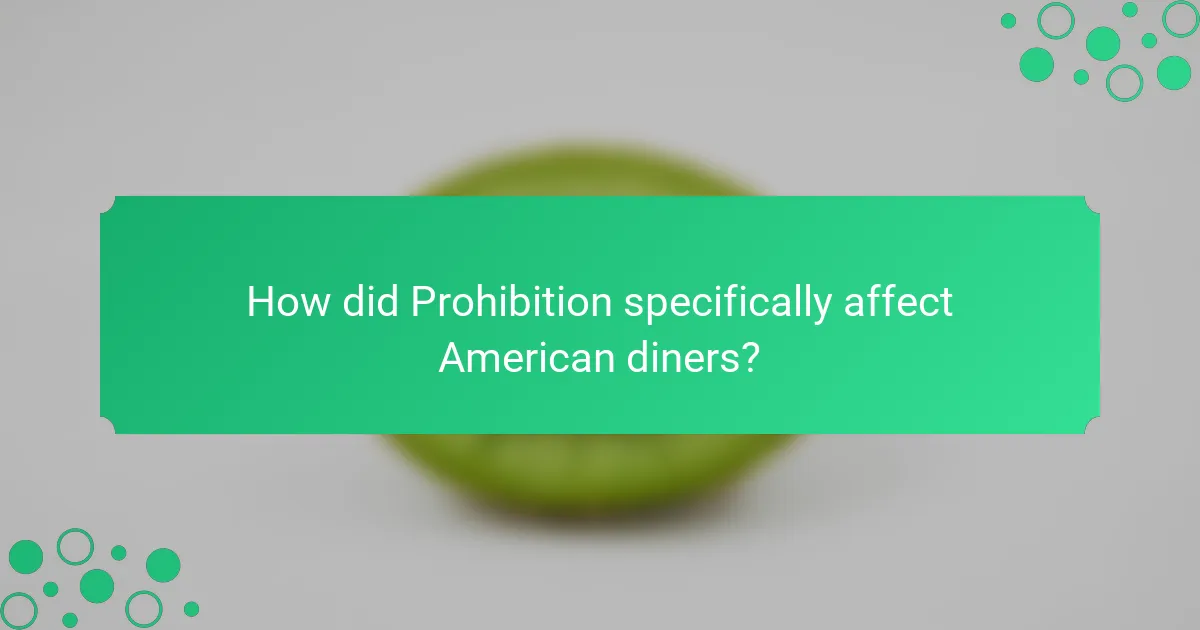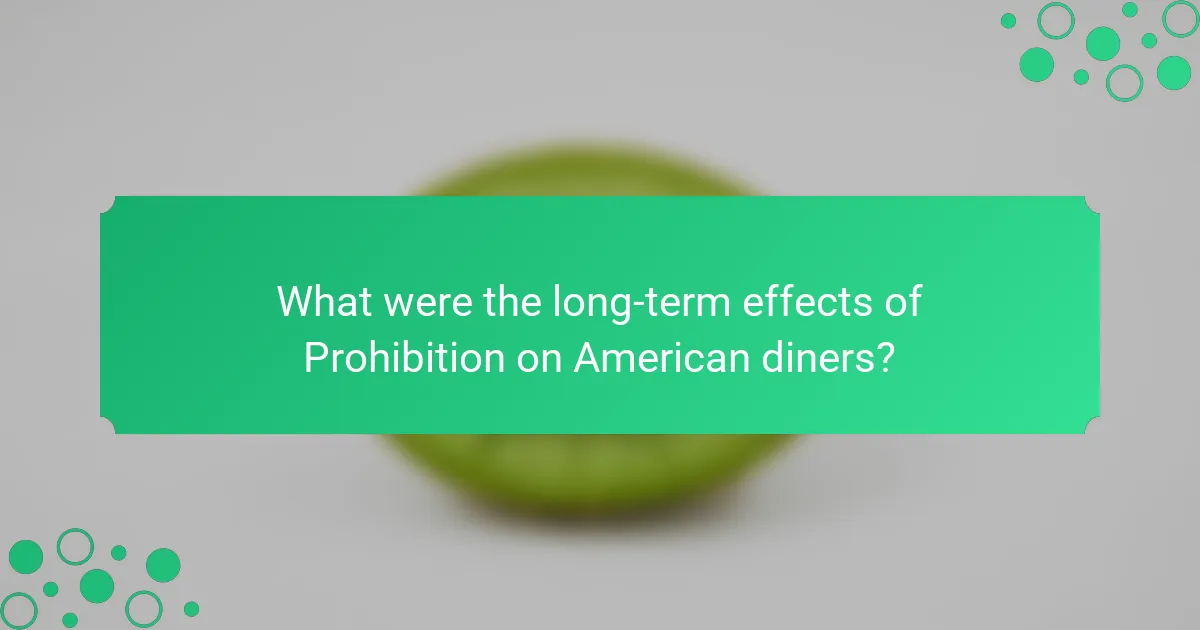The Prohibition Era in America, spanning from 1920 to 1933, was marked by the legal ban on the manufacture, sale, and transportation of alcoholic beverages under the 18th Amendment. This period aimed to reduce crime and improve societal health but instead fostered illegal speakeasies and organized crime, ultimately leading to its repeal by the 21st Amendment. The impact of Prohibition extended to American diners, which adapted their menus and social dynamics to accommodate the demand for illicit alcohol. Many diners transformed into speakeasy-style venues, creating vibrant environments while facing economic pressures that altered staffing and food quality. The legacy of Prohibition significantly influenced the evolution of American dining culture, shaping diner aesthetics and fostering a culture of secrecy and innovation.

What was the Prohibition Era in America?
The Prohibition Era in America was a period from 1920 to 1933 when the manufacture, sale, and transportation of alcoholic beverages were banned. This was established by the 18th Amendment to the U.S. Constitution. The goal was to reduce crime and corruption, improve health, and strengthen families. Instead, Prohibition led to the rise of illegal speakeasies and organized crime. The law was widely disregarded, and many Americans continued to consume alcohol. The unintended consequences included increased violence and a loss of tax revenue. Prohibition was ultimately repealed by the 21st Amendment in 1933.
How did Prohibition come into effect?
Prohibition came into effect with the ratification of the 18th Amendment in 1919. This amendment prohibited the manufacture, sale, and transportation of alcoholic beverages in the United States. The Volstead Act, enacted to provide for the enforcement of Prohibition, defined intoxicating liquors and outlined penalties for violations. The movement towards Prohibition gained momentum through the efforts of various temperance organizations, notably the Women’s Christian Temperance Union and the Anti-Saloon League. These groups argued that alcohol was the root cause of societal issues such as crime and domestic violence. Public support for Prohibition was also influenced by World War I, as many viewed it as a patriotic duty. The combination of legal frameworks and social advocacy led to the nationwide enforcement of Prohibition starting in January 1920.
What were the key events leading to the enactment of Prohibition?
The key events leading to the enactment of Prohibition include the rise of the temperance movement, the influence of religious groups, and the passage of the 18th Amendment. The temperance movement gained momentum in the late 19th century, advocating for the reduction or elimination of alcohol consumption. Religious groups, particularly Methodists and Baptists, supported this movement, citing moral and health concerns. The Anti-Saloon League was formed in 1893, becoming a powerful political force advocating for prohibition laws. In 1919, the 18th Amendment was ratified, making the manufacture, sale, and transportation of alcohol illegal. This amendment took effect in January 1920, marking the official start of Prohibition in the United States.
What laws were implemented during Prohibition?
The laws implemented during Prohibition included the 18th Amendment and the Volstead Act. The 18th Amendment, ratified in 1919, prohibited the manufacture, sale, and transportation of intoxicating liquors. The Volstead Act provided the legal framework for enforcing Prohibition. It defined intoxicating liquors as any beverage containing more than 0.5% alcohol. These laws aimed to reduce alcohol consumption and its associated social issues. They led to the rise of illegal speakeasies and bootlegging operations. Enforcement of these laws faced significant challenges and resistance from the public. Prohibition ultimately lasted from 1920 until its repeal in 1933 with the 21st Amendment.
What impact did Prohibition have on American society?
Prohibition significantly impacted American society by altering social behaviors and economic structures. It led to the rise of organized crime, as illegal production and distribution of alcohol became lucrative. Speakeasies emerged as underground bars, changing nightlife culture. Law enforcement struggled to control illegal activities, which undermined respect for the law. Additionally, Prohibition affected employment in industries related to alcohol, leading to job losses. The movement also sparked debates about personal freedoms and government intervention. Ultimately, the 18th Amendment was repealed in 1933, highlighting its unpopularity and the societal challenges it created.
How did Prohibition affect crime rates in urban areas?
Prohibition significantly increased crime rates in urban areas. The 18th Amendment, enacted in 1920, banned the manufacture and sale of alcohol. This created a lucrative black market for illegal alcohol. Organized crime syndicates, such as the Chicago Outfit, thrived during this time. They engaged in violent turf wars over control of the illegal liquor trade. Homicides and violent crime rates surged in cities like Chicago and New York. Law enforcement struggled to combat the rise of gang violence. By the end of Prohibition in 1933, crime had escalated to unprecedented levels.
What were the social attitudes towards drinking during Prohibition?
During Prohibition, social attitudes towards drinking were largely negative among supporters of the movement. Many viewed alcohol consumption as a moral failing and a cause of societal issues like crime and domestic violence. Conversely, a significant portion of the population continued to drink despite the ban. Speakeasies and illegal bars flourished, indicating a strong counterculture against Prohibition. The 18th Amendment, which enacted Prohibition, faced widespread resistance. Public opinion polls from the era showed that many Americans disapproved of the law. The social landscape reflected a divide between proponents of temperance and those who enjoyed drinking. This conflict shaped the cultural dynamics of the 1920s in the United States.

How did Prohibition specifically affect American diners?
Prohibition significantly impacted American diners by altering their menus and social dynamics. Many diners began to serve food that paired well with illicit alcohol, such as hearty meals and snacks. This change catered to patrons seeking a place to enjoy their drinks discreetly. Additionally, some diners transformed into speakeasies, offering hidden areas for drinking. The atmosphere in diners shifted to a more vibrant and secretive environment. Furthermore, the economic pressure of Prohibition led some diners to cut costs by reducing staff or altering food quality. Overall, Prohibition reshaped American diners into hubs of social interaction amidst the constraints of the law.
What changes did diners experience during Prohibition?
During Prohibition, diners experienced significant changes in their offerings and social dynamics. Many establishments transformed into speakeasies, serving illegal alcohol alongside meals. The absence of legal alcohol led to a shift in dining culture, with an emphasis on food pairings with homemade or smuggled spirits. Diners often faced increased scrutiny from law enforcement, impacting their operations. Menus became more focused on non-alcoholic beverages, such as sodas and mocktails. The overall atmosphere in diners shifted to one of secrecy and discretion. Social interactions in dining settings changed, as patrons sought to evade detection while enjoying meals. This era also saw a rise in culinary creativity, as chefs adapted to new regulations and customer preferences. The changes reflected broader societal shifts and the influence of Prohibition on American dining culture.
How did the menu offerings at diners change?
Menu offerings at diners changed significantly during and after Prohibition. Many diners expanded their menus to include more substantial meals. This shift occurred as alcohol was banned, leading to a focus on food as a primary draw. Diners began to offer a wider variety of dishes, including breakfast items, sandwiches, and desserts. The introduction of new cooking techniques and ingredients also influenced menu diversity. Additionally, diners adapted to changing consumer tastes, incorporating regional specialties. This evolution reflected broader social changes during the Prohibition era. Overall, the menu transformation was a response to both the legal landscape and customer demand for diverse dining options.
What were the economic impacts on diner businesses?
Diner businesses experienced significant economic impacts due to Prohibition. Many diners relied on alcohol sales for revenue. The ban on alcohol reduced customer traffic and overall sales. Some diners adapted by expanding their food menus. Others faced financial difficulties and closed permanently. The economic strain led to job losses in the diner sector. Prohibition also encouraged the rise of speakeasies, diverting customers away from legitimate diners. Overall, the economic landscape for diner businesses changed drastically during this period.
What role did diners play in the social landscape during Prohibition?
Diners served as social hubs during Prohibition, fostering community connections. They provided a space for people to gather and socialize in a time of restricted alcohol consumption. Many diners adapted by offering non-alcoholic beverages and food, creating an inviting atmosphere. The rise of speakeasies nearby often led patrons to visit diners before or after these illicit establishments. Diners became essential for socializing, especially for those seeking a sense of normalcy. In urban areas, they reflected the changing cultural landscape, attracting diverse groups. This adaptability helped diners maintain relevance during the tumultuous Prohibition era. Their role in the social fabric was significant, bridging gaps in a society navigating new laws.
How did diners serve as social hubs during this time?
Diners served as social hubs during Prohibition by providing a gathering space for communities. They offered affordable meals and a casual atmosphere, attracting diverse groups. Diners became venues for conversation and social interaction. They often featured jukeboxes and counter seating, enhancing the communal experience. Additionally, diners adapted to the absence of alcohol by serving creative non-alcoholic beverages. This shift helped maintain social connections despite the restrictions of Prohibition. Historical accounts indicate that diners played a crucial role in fostering local camaraderie during this era.
What unique practices emerged in diners due to Prohibition?
During Prohibition, diners adapted by creating speakeasies, hidden bars serving illegal alcohol. These establishments often operated discreetly to evade law enforcement. Diners also began offering elaborate non-alcoholic beverages, like mocktails, to attract patrons. Additionally, some diners incorporated secret menus that featured alcoholic drinks disguised as food items. The atmosphere in diners shifted to a more clandestine vibe, encouraging a sense of rebellion. This led to increased social gatherings and a vibrant nightlife culture within these eateries. Historical records indicate that many diners thrived during this time, capitalizing on the demand for illicit drinks.

What were the long-term effects of Prohibition on American diners?
Prohibition had significant long-term effects on American diners. Many diners adapted by creating speakeasy-style atmospheres to serve illicit alcohol. This led to a culture of secrecy and innovation in dining experiences. The need for creative menus arose as diners sought to attract patrons despite restrictions. Additionally, the era fostered a rise in organized crime, impacting diner safety and operations. Once Prohibition ended in 1933, many diners shifted towards more legitimate business practices. The legacy of this period influenced diner aesthetics, with a focus on social interaction and community. Overall, Prohibition shaped the evolution of American dining culture in profound ways.
How did the end of Prohibition reshape diner culture?
The end of Prohibition significantly reshaped diner culture by allowing the legal sale of alcohol. Diners began to incorporate bars and alcohol into their offerings. This change transformed diners from primarily food-focused establishments to social hubs. The availability of alcoholic beverages attracted a wider clientele. Diners became places for social gatherings and celebrations. The shift also led to an increase in late-night dining. This change reflected broader societal shifts towards more relaxed attitudes about drinking. Overall, the end of Prohibition helped diners evolve into vibrant community spaces.
What lasting changes in diner operations occurred post-Prohibition?
Post-Prohibition, diner operations saw significant changes. The legalization of alcohol led to the introduction of bar areas in diners. Diners began to offer a wider variety of food and drink options. This included cocktails and specialty beverages that were previously unavailable. The shift in consumer preferences influenced menu diversification. Additionally, diners adopted longer operating hours to accommodate nightlife. Increased competition from bars and restaurants prompted diners to enhance their service quality. These operational changes contributed to the evolution of the American diner culture.
How did diners adapt to the reintroduction of alcohol?
Diners adapted to the reintroduction of alcohol by modifying their dining experiences. They began to incorporate alcohol into meals as a social norm again. Restaurants updated their menus to include wine pairings and cocktail options. Diners also embraced the cultural shift towards enjoying alcoholic beverages in social settings. This change reflected a broader acceptance of alcohol in public life. Historical records indicate that sales in restaurants increased significantly after Prohibition ended in 1933. This resurgence in alcohol consumption played a crucial role in revitalizing the dining industry. Overall, diners adjusted their habits to align with the newfound availability of alcohol.
What lessons can be learned from the impact of Prohibition on diners?
The impact of Prohibition on diners reveals important lessons about consumer behavior and economic adaptation. During Prohibition, many diners transformed into speakeasies to serve alcohol illegally. This shift demonstrates how businesses can innovate under restrictive regulations. Diners adapted their menus and services to attract customers seeking an alternative social experience. The era also highlighted the resilience of the dining industry in response to changing laws. Furthermore, the cultural significance of dining as a social hub was reinforced during this time. Historical data shows an increase in diner popularity despite legal challenges. Overall, the Prohibition era exemplifies the adaptability of the dining sector in the face of adversity.
How can modern dining establishments learn from the Prohibition era?
Modern dining establishments can learn from the Prohibition era by adopting innovative strategies to enhance customer experience. During Prohibition, speakeasies thrived by creating unique atmospheres and exclusive offerings. They often had secretive entrances and a sense of adventure that attracted patrons. This highlights the importance of ambiance and exclusivity in modern dining.
Additionally, speakeasies developed creative cocktails to mask the poor quality of illegal alcohol. This reflects the value of creativity in menu design. Modern establishments can focus on crafting unique dishes and drinks that stand out in a competitive market.
Prohibition also led to the rise of food pairings with beverages, emphasizing the connection between culinary experiences. Establishments today can enhance their menus by thoughtfully pairing food and drinks, creating a more cohesive dining experience.
Furthermore, the era showcased the resilience of the restaurant industry in adapting to challenges. Modern dining establishments can learn to be flexible and innovative in response to changing regulations and consumer preferences. This adaptability can lead to sustained success in a dynamic market.
What best practices can be adopted to navigate similar societal changes?
Adopting clear communication strategies is essential to navigate societal changes. Effective communication fosters understanding and collaboration among stakeholders. Engaging with communities through forums and discussions builds trust. Implementing educational programs raises awareness of the changes and their implications. Adapting policies to reflect societal needs ensures relevance and responsiveness. Monitoring public sentiment through surveys helps gauge community reactions. Utilizing data analysis informs decision-making processes. Historical examples, such as the Prohibition era, illustrate the importance of these practices in addressing societal shifts.
The main entity of this article is the impact of Prohibition on American diners. The article provides a comprehensive overview of how the Prohibition Era, lasting from 1920 to 1933, transformed diner culture, menu offerings, and social dynamics. It explores the legal framework established by the 18th Amendment and the Volstead Act, the rise of speakeasies, and the economic challenges faced by diners during this period. Additionally, it discusses the long-term effects on diner operations and the lessons modern establishments can learn from this historical context. The article highlights the resilience and adaptability of diners amidst restrictive regulations and changing societal attitudes towards alcohol consumption.



